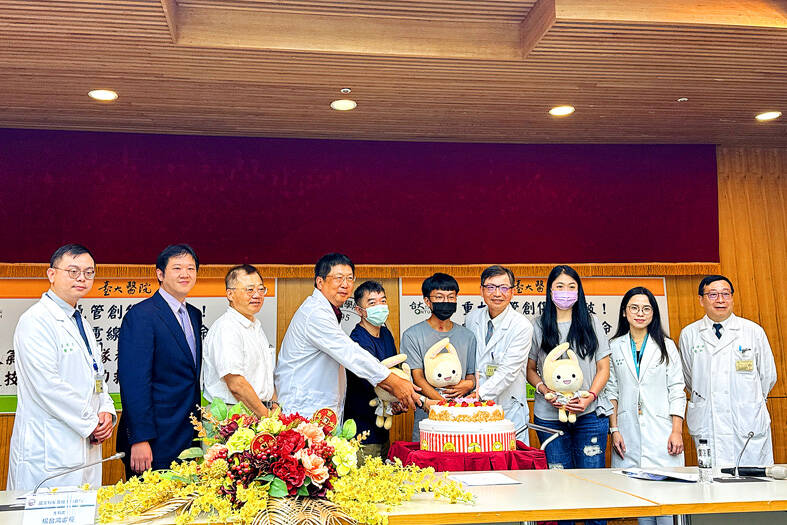A motorcyclist who was strangled by a power line during a typhoon last year has become the first person in the world to have a traumatic tracheal rupture repaired using an aortic transplant, the National Taiwan University Hospital (NTUH) said on Wednesday.
During Typhoon Koinu in October last year, a 24-year-old man surnamed Tseng (曾) was riding his motorcycle home from work in Yunlin county when the accident occurred, chairman of NTUH’s Department of Surgery Chen Jin-shing (陳晉興) said at a press conference.
After initial treatment at a local hospital, Tseng was transferred to the Yunlin branch of NTUH, where he developed further complications, including severe tracheal stenosis that forced him to rely on a tracheostomy tube to breathe and a nasogastric tube to eat due to airway blockage, Chen said.

Photo: Chiu Chih-jou, Taipei Times
“Everyone can imagine how difficult it would be for a 24-year-old man to depend on a tracheostomy and a feeding tube for the rest of his life,” Chen said.
Tseng was then referred to NTUH in Taipei, where Chen’s team performed tracheal reconstruction using an aortic transplant from an organ donor in October last year.
The patient recovered well after the operation, was taken off the ventilator the day after the operation and was discharged in December, Chen said.
Tseng had his tracheal tube removed in April and has since led a normal life and is able to eat and speak again, NTUH said in a press release.
Such cases are rarely successful because many patients either still suffer on site or are dependent on a tracheostomy tube for the rest of their lives, Chen said.
The operation was the first case in the world of repairing a traumatic tracheal rupture using an aortic graft. The case was accepted for publication last month by JTCVS Techniques, a peer-reviewed journal, he added.
Regarding the difficulties in performing reconstruction, Chen said that while short tracheal lesions can be easily treated by resection and reconnection, lesions larger than 5 cm pose significant challenges.
“If the trachea cannot be restored due to tumors, stenosis or severe trauma, reconstruction or even transplantation becomes necessary,” he said.
Tracheal reconstruction or transplantation using donated or artificial tracheas has long been a challenging task in pulmonology due to frequent transplant rejection, he added.
Building on the work of French researcher Emmanuel Martinod in 2018, Chen and his team have successfully treated three patients with severe tracheal disease since 2021 as part of a human clinical trial program approved by the Ministry of Health and Welfare, the press release said.
The team used a tissue engineering technique with aortic transplants stored at minus 80 °C, which were thawed before implantation and supported by tracheal stents to maintain their shape. This made blood group determination and the intake of immunosuppressive drugs unnecessary, it was said.
When asked about the principle of the technique, Chen explained that after an aorta is thawed, all cells die and only a structure remains that resembles that of a trachea and therefore does not trigger transplant rejection.
“It (the implanted aortic graft) acts like a bridge or an empty house… As the recipient’s (trachea) cells grow inside, they develop into mucosal and cartilage cells, gradually transforming the aorta into a trachea,” he said.
Comments are moderated. Comments must be relevant to the article. Comments containing offensive or obscene language, personal attacks of any kind, or advertising will be removed and the user banned. The final decision is at the discretion of the Taipei Times.
